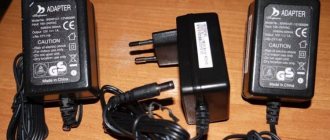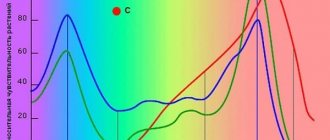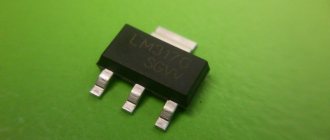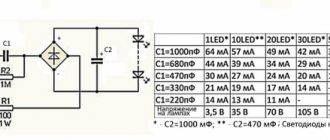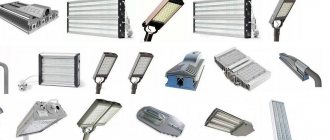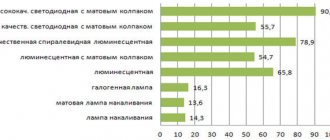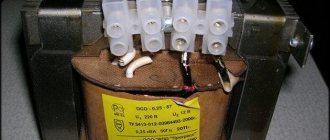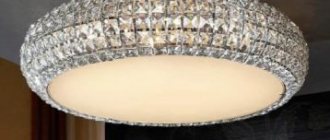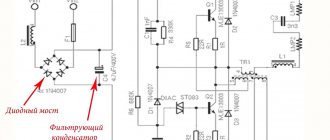Lighters based on LED strips are becoming increasingly popular over time and are successfully used for various purposes. Today they are used not only for decorating indoor and outdoor spaces, but also for arranging general lighting. In addition, with their help it is possible to realize the idea of commercial lighting effects that attract attention to billboards and banners. Power supplies for illuminators designed for reduced voltage include transformers for 12-volt LED strips (TP).
Electrical connection
Manufacturers offer LED strips with various parameters for sale. In most cases, the power supply for LED strips is a network providing a voltage of 220 V. But not all LED devices are designed to be connected to a regular outlet. The tapes that are in greatest demand among consumers require a power source with voltage parameters of 12 V or 24 V. If they are connected directly to an outlet, they will not work and may burn out. These devices are designed for a completely different level and type of voltage, and such an LED device must be connected via a transformer. For LED lighting, developers present special transformers for LED strips that provide a stable output voltage.
Interesting material for review: useful information about current transformers.
Connecting the transformer to the power supply.
What to look for when choosing
Today there is a huge selection of power supplies that are suitable for LED strips. The important criterion is which one is right for you.
- The transformer must have a system that provides a smooth start. This will increase the service life of the tape;
- The device should not have a lower rated power than the power of the LED strip. It is worth making sure that the transformer has 20% power in reserve;
- Choose a location for installing the device so that, if necessary, it is easy to reach. If you install it in a cramped room, it will heat up, which will cause it to break;
- The degree of protection of the transformer is important;
- As we have already said, transformers can be sealed or non-sealed, in accordance with this, the installation location is determined;
- Sealed power supplies, which have a degree of protection IP 67, can be installed in bathrooms, saunas, and also outdoors. This degree of protection is sufficient to avoid the possibility of short circuit, overload, overheating, and the device is not afraid of voltage surges in the network;
- Non-sealed power supplies are suitable for installation in dry and ventilated areas, with a degree of protection IP 20.
power unit
Installed illuminated advertising using LEDs will require a separate power supply. In our case, such a power supply is called a transformer for an LED strip. This happens because such units (by the way, another common name for such a device is an adapter) initially used transformers. And such devices ensured a constant output voltage. Now, to power LED devices, DC sources are most often used - they are called drivers, or even more complex devices - controllers.
It will be interesting➡ What are isolation transformers
But let's return to power supplies. The power supply for the LED strip should be selected taking into account the following parameters:
- voltage;
- power;
- protection from moisture.
The block should be selected for each specific case. The supply voltage of the LED strip must correspond to the values of 12 and 24 V. Therefore, we select a device that is capable of providing the specified voltage. The next point is calculating the required power. To power one meter of LED strip, a very specific amount of power is required. Accordingly, the power of the power supply is selected based on calculations: the power consumed by one meter of tape multiplied by the total length of the connected segment.
Another 25% is added to this figure for a reserve for unforeseen situations. Often, the selection of a power supply for an LED strip is required taking into account its ability to withstand moisture. If the unit is planned to be installed in a dry room, we choose a conventional device called an interior unit. For installation outdoors or in a room with high humidity levels, you will need a waterproof power supply.
How to choose a transformer for lamps
Content:
A transformer is a device that is designed to convert alternating current of one voltage into alternating current of another voltage. These devices are divided into current transformers, which are powered by a current source, and voltage transformers, which are powered by a voltage source.
They, in turn, are divided into so-called step-down current or voltage transformers and reduce the current or voltage values to specified limits. Step-down voltage transformers, as a rule, have found their application when connecting electric lamps. A huge selection of lamps with halogen lamps involves the use of step-down transformers. Lamps require a voltage of 12 V, and from the socket we are offered 220, so the use of transformers is necessary so that the lamp does not fail. Transformers can be electronic, they are used for halogen and LED lamps, and electromagnetic ones are necessary for track systems. The use of a step-down transformer extends the service life of the lighting source, and the surface in which it is mounted does not overheat, thereby ensuring a high level of safety. Electronic transformers are compact in size, which allows installation in narrow spaces. A huge selection of step-down transformers can become a problem for an inexperienced consumer in this matter. After all, an error in choice can cause a decrease in the brightness of the lighting and deterioration in the operation of the device. When choosing an electronic transformer for halogen lamps, keep these parameters in mind. 1. The efficiency of the device should tend to unity. 2. Temperature thresholds. The wider the temperature range in which the transformer can operate, the better. However, when used indoors, this parameter is not of great importance. 3. Operating voltage range. 4. Power. 5. Moisture and dust resistance class. Application of step-down transformers Step-down transformers can find their application in rooms with high humidity - bathrooms, basements, cellars. Due to its compactness and low weight, the transformer can be installed on a suspended ceiling, a furniture shelf, or attached to a chandelier box. As a rule, the reliability of a transformer depends on the manufacturer and, accordingly, the price of the product. High-quality transformers are protected against short circuits, overheating, and have a soft-start device for lamps. In order to correctly select the power of the transformer you need, you need to add the power of the lamps connected to it (in w) with a 10% margin. For example, if we have 5 20w light bulbs, then the ideal option for you would be a transformer with a power of 110-115 w
Please note that exceeding the rated load of the transformer and loading more than 90% is strictly prohibited. Divide the lamps into groups and install a transformer for each of them
Overview of types and principle of operation
Such devices operate according to a similar scheme: the 220V mains voltage is converted to a lower voltage - 12V. This feature is realized by means of a transformer, which reduces the voltage to the level of 12V. This is the simplest power supply that allows you to connect low-power lighting devices. To install more powerful lamps, power elements designed for 24V, 36V, 48V are used. In addition to the step-down transformer, the design of the unit includes a rectifier, stabilizer and filters (RC or LC).
There are two types of such devices, which differ in the cooling method:
- with passive heat transfer;
- with active cooling system.
In the first case, the power supply can be made in a closed or perforated case, and the heating intensity of the case is reduced through natural cooling.
Interesting reading: facts about step-down transformers.
The second option includes a fan in the design. Such a unit has very significant disadvantages: the need to regularly clean the device, since the fan pumps in quite a lot of dust, and, in addition, during operation, an obsessive noise is heard, which does not always suit the owner of the room. There are different versions of the power supply unit for the LED strip, different in size. If you plan to install decorative low-power lighting, you can use a compact version.
In addition, the market offers models of devices that differ in the material from which the body is made: plastic, aluminum. The main difference is the set of functions:
- providing power to the light source;
- devices with built-in dimmer;
- possibility of remote control;
- Full-featured devices: with dimmer and remote control function.
The power range of such equipment can vary from 4 to 2,000W. If you plan to install the lighting in a room with a high level of humidity, use a special type of power supply - a moisture-proof one.
Purpose and classification of transformers
The main purpose of a power supply or transformer is implied in its name - converting the mains voltage from 220 volts to 12V. In practice, four main types of blocks are used:
In plastic cases. Their main advantage is naturally their compactness, presentable appearance and light weight. We can also mention tightness, but at the same time it leads to the main disadvantage of such systems - the complexity of heat transfer. This directly limits the power of the lighting fixture that can be connected. In the picture on the right you can see a 12 volt block,
In aluminum cases. Compared to the previous type, it is more expensive and weighty. But the sealed metal case, on the contrary, does not complicate, but promotes heat exchange. Such devices are more durable, reliable and durable. They are resistant to the negative influence of the external environment, therefore they are used in external advertising products,
Open type. The most widespread and cheapest, due to its simplicity, version of the transformer. Larger than previous models, it also has a less presentable appearance. They also have a fairly low level of dust and moisture protection (if they are provided for by the design at all),
Compact type. A small, simple device in design and operation, which implements the principle of non-stationary installation. Their power does not exceed 60 W. Used to power belts of standard length (no more than 5 m). This unit is very easy to connect, which is its main advantage.
Classification of LED strips
The wide variety of single-color LED strips has led to their classification according to several main criteria. These criteria will be described below.
Classification of transformers for lighting.
By type of LEDs used
The main distinguishing feature of LED strips is the type of diodes used in the manufacture of the product. Basically, single-color LED strips are produced on the basis of SMD 3528 and SMD 5050 diodes. The abbreviation SMD means that this electronic component is designed for mounting on the surface of a printed circuit board. Full marking also includes the dimensions of the product in millimeters: for example, the SMD 3528 LED has a length of 3.5 mm and a width of 2.8 mm.
It will be interesting➡ The design of a toroidal transformer and its advantages
By LED density
LED strips are also divided by the number of elements (diodes) used in one meter of strip, which in technical circles is called density. It is worth noting that the number of LEDs used in the manufacture of one meter of strip affects the total power of the product, as well as its light indicators (degree of illumination). The denser the LEDs are, the more of them can be placed on a piece of tape and the brighter the light will be. Calculation of LED strip power parameters is presented in the table below.
Table for calculating power parameters for LED strip.
By power
The power of LED strips, like other radio products or equipment, is measured in watts (W). The value of this parameter is determined by the dimensions of the diodes and their density. For example, a typical LED strip made from SMD 3528 consumes:
- 4.8 W if 60 diodes are installed on each meter;
- 9.6 W, if the LED density is twice as high - 120 diodes per meter;
- 19.2 W, if the diodes are in two rows, and their total number per meter is 240 pcs.
For SMD 5050 based tape, the power consumption will change as follows:
- 30 diodes/meter - 7.2 W;
- 60 diodes/meter - 14.4 W;
- 120 diodes/meter - 28.8 W.
It's not difficult
Please note that for the same type of strip, power consumption is directly proportional to the number of installed LEDs. This is understandable - each diode consumes one
the number of watts.
Features and characteristics of LED sources
Various samples of LED products differ in a number of characteristics, the main of which are:
- direction of light flux;
- installation density;
- rated supply voltage;
- degree of protection.
According to the first indicator, known examples of LED devices are divided into front and end products. The most widespread are tapes with frontal orientation and a dispersion angle of about 120 degrees. Flexible strips with a side emission source are not so popular, since their radiation is limited to an angular radius of 90 degrees.
The amount of luminous flux from an LED strip is proportional to the number of emitting elements installed on it per linear meter. According to the existing classification, this number is selected from the following series: 30, 60, 90, 120 and 240 point units. The supply voltage for low-voltage tapes is either 12 or 24 Volts. Higher values are extremely rare.
Different brands of LED strips differ in their protection from dust and moisture. The protection class is indicated on the product packaging as a combination of the letters IP and the two numbers following them. The strip with open mounting of diode elements belongs to class IP20 - there is no sealing at all. The tape, which is maximally protected from climatic influences, has the highest degree, designated as IP68.
Key selection parameters
To select a power supply for an LED strip, you need to pay attention to several basic technical characteristics of such devices:
- the voltage level at the output of the block must correspond in value to the light source that will be connected;
- the power value of the device; to determine the design suitable for the load, a simple calculation should be performed;
- degree of protection;
- the need for additional functions in the block.
When deciding which power supply to choose, it is recommended to take into account its cost. Moisture-proof versions will cost more. Pricing is also affected by the level of power and voltage. The simplest option can be bought for 200 rubles. (protection level IP20), expensive versions can be found at a maximum price of up to 5,000 rubles. (waterproof housing, 250W).
How are multiple blocks calculated?
When you need to use a strip of LEDs 10 or more meters long, then 5 m long sections are connected to different terminals of the power supply according to the circuit.
This solution has a drawback - large DC losses in the wires. Diodes that are located far from the power adapter will glow dimly. By the way, to avoid such losses, alternating current with high voltage is used to transmit current over long distances. Therefore, it is better to use several power supplies. They are connected according to this scheme.
It is advisable to place the adapters evenly along the entire tape, and not collect them in one mounting box. Then they won't overheat.
The calculation method does not differ from that used for one block.
- For example, you need to illuminate a room 3x6 meters. The perimeter will be 18 m. For lighting, SMD 3528 60 LEDs/M tape is used, which has a brightness of 360 lm/m. n. Its power is equal to:
(6.6 W/m) * (18 m) = 118.8 W.
- Add a power reserve factor of 25%. The output is:
118.8 W * 1.25 = 148.5 W.
It turns out that the total power of one power adapter should be 150 W.
The longest length of a standard LED strip is 5 m. For lighting you will need 3 segments of 5 m each and 1 segment of 3 m long. These 4 segments will require 2 power supplies.
The first one will have the power:
(5 m + 5 m) * (6.6 W/m) * 1.25 = 82.5 W. Choose a 100 W adapter.
Other power:
(5 m + 3 m) * (6.6 W/m) * 1.25 = 66 W. An 80 W unit will do.
The operating conditions of 2 power supplies are easier than one, because in total they have more power (180 W versus 150 W). Therefore, this connection scheme is more reliable and is not so afraid of overheating.
Calculation of sufficient power value
In order not to make a mistake and select the power supply element for the LED strip with the required parameters, you should first determine the total length of the light source, which is influenced by the size of the illuminated room. In the technical specifications, the manufacturer indicates the power value of a section of strip 1 m long. Accordingly, to determine the maximum load level on the power supply, you should multiply the total length of the tape by the power of 1 m. Additionally, you need to add 15-20% to the resulting value.
Thus, the power supply allows the connection of LED light sources. But in addition to the main function - power supply, such devices also solve other problems, for example, they protect the lighting device from power surges thanks to the built-in stabilizer. In order not to make a mistake when purchasing, you need to calculate the power value. The main parameters that are used when calculating the power of the power source are: linear power consumed per 1 meter of tape (Ribbon), the number of diodes at the same distance and output voltage 12/24 V.
It will be interesting➡ What you need to know about current transformers
Let's carry out power calculations using the example of an SMD 3528 LED strip with a length L = 6 m (60 diodes/m and P strip = 4.8 W/m) and a supply voltage of 12 V. According to the calculation results, it turned out that this entire strip consumes Ppot = 28.8 Tue. For greater clarity, let’s duplicate the previous calculation here: Pconsumption = Ribbon × L = 4.8 W/m × 6 m = 28.8 W. To ensure that the power supply does not overheat, the power should be calculated with a margin (a margin of 33% is taken). Let's use the formula: PBP= Ppot+33%=28.8+9.54=38.3 W.
Based on the calculation, we select a power supply from the standard line of the manufacturer of interest, for example, 40 W. Using similar formulas, we calculate the power for the SMD 5050 120 LED strip (120 diodes per meter). This product has the following parameters:
- Tapes=28.8 W;
- density 120 diodes/m;
- supply voltage 24 V;
- tape length L = 2.5 m.
Let's assume that we cut the required amount from the standard length of 5 m). Pconsumption = Tape × L = 28.8 W/m × 2.5 m = 70.2 W. PBP= Ppot+33%=70.2+23.16=93.4 W. In this case, choose a 100 W power supply. It is worth noting that using these formulas, you can easily and simply calculate the power of the power supply for LED strips with any parameters.
Let's start the calculations
Since you cannot plug an LED strip into a standard outlet, to connect it, as we have already found out, you should use a power supply with a specific power.
The size of this parameter can be calculated mathematically. But to do this you need to know how it is done. Today, LED strips are produced with voltages of 12 and 24 volts. To calculate the power, you need to know the type of tape used (for example, SMD 5050 RGB tape) and how many LEDs are placed on one meter of its length. For this type of tape, 30 LEDs are placed on one meter. To find out this value for other models, you need to use the following table.
Table. Number of LED strips per meter
The power calculation itself consists of the following steps:
- First, we find out how much power one meter of lighting fixture will consume. This parameter is already given in the table;
- Next you need to calculate how much power the whole tape will consume. To do this, you simply need to multiply the total length of the backlight by the power of one meter. For example, in our case, it is necessary to multiply 10 meters (we will take this length for ease of calculation) by 7.2 watts. The result is 72 watts.
In fact, this is the whole calculation. You just need to perform the last action, which, if done incorrectly, can nullify all your mathematical calculations. The required power for the power supply to connect an LED strip to it should include a reserve that will protect the device from possible overloads. Typically, the reserve is at least 20% of the total power of the lighting installation, i.e. in our case from 72 watts. Some recommend taking as much as 30% to be sure.
Note! These 23 or 30% of the reserve, for ease of calculation, can be represented as a safety factor. For 20% it will be 1.20, for 25% - 1.25, and for 30% - 1.30
If we take a margin of 30%, then the final figure will no longer be 72 watts, but 93.4 watts. It is this power (rounding of the value is allowed) that you should buy a power supply of the type that you like best in terms of its technical characteristics or operating features. Remember that correctly calculated converter power is the key to long-term and high-quality operation of the backlight connected to it. Therefore, mathematical calculations in this situation must be approached very responsibly if you want to go to the store or market for a new power supply as little as possible.
Connecting an LED strip to one power supply
Most often, an LED strip is a solid five-meter piece that is wound on a plastic reel. As a rule, from the outside - on the end that is not wound on the reel - the wires necessary for connecting to the power supply are connected to the tape.
If after purchase you find that there are no connecting wires, then you should take any stranded wires of red (“+”) and black (“-”) colors, measure the required length, which should be enough to reach the terminals of the power supply, and solder them, having previously cleaned and tinned both ends. We tin the wires using rosin and tin, and connect them to the tape tracks using soldering.
During the soldering process, you should use a low-power soldering iron and make the connection quickly enough, since there is a possibility that the LEDs may be damaged due to exposure to elevated temperatures. After this, we connect the free ends of the wires (not soldered to the tape) to the power supply, observing the polarity.
Correct connection with diagrams and photos
Since a strip with diodes can operate on a voltage of 12 or 24 volts, we need to connect a step-down unit (transformer) to it. On one side it is connected to a 220 volt power supply, and on the other side to the tape board.
It is imperative to keep in mind that there are two different colored wires at the output of the transformer. Also, the tape has two different wires - red and blue (sometimes black).
Red means "plus" and blue means "minus". Therefore, when connecting the tape, the indicated polarity must be observed. Plus goes to plus, and minus to minus. If an error occurs, the device will not turn on.
Connection diagram of the transformer to the LED strip
We connect a tape more than 5 meters long
Many people make the mistake of starting to connect pieces of tape to each other. The beginning of the second is connected to the end of the first tape. But it's not right.
Incorrect connection diagram of the LED strip to the power supply
The second piece of LED strip will shine much dimmer, and the final diodes will be completely dim. With a low-power tape such as SMD 3028, where there are 60 diodes, the brightness level will be approximately the same. But the current will flow along the line of tracks much more than the working one. They will overheat greatly, and this will have a detrimental effect on the diodes. The use of such a scheme significantly reduces the life of the tape. In this case, you must use the diagram below.
Connection diagram of two serial diode strips to one power supply
It is intended for one power supply, where the power of the device must be equal to the sum of 2 tapes or more.
In order for the required voltage to be brought to the second board of the tape, it is necessary to add another wire to the output of the device for extension. We connect its second end to the 2nd tape. As a result, the current will flow through the wire itself, and not along the conductive lines.
The cross-section of the cable for extension must be sufficient to avoid voltage loss. Usually they take a wire five meters long with a cross-section of 1.5 millimeters. Installation is carried out in a niche, next to the first piece of tape.
This scheme is used if it is possible to hide a large transformer. And if not, then it is recommended to use a slightly more complicated scheme. In this case, the wire to extend the circuit (0.75 mm) is connected to a 220-volt power supply and routed to the transformer of the second tape.
Connection diagram for LED strips with two power supplies
Installing the tape according to this scheme is somewhat more complicated, since a second supply transformer is required, but in this case the power level of the devices is reduced by approximately half. Their dimensions are also much smaller.
How to properly connect RGB strip, controller and amplifier
A multi-color LED strip is connected in the same way as a single-color one, but in this case you need to install a special controller between it and the transformer. They come in various types and differ in their appearance, power level, color management programs and other parameters. But the principle of operation is the same for all: two wires from the transformer went to the controller, and 4 went out to the LED strip.
Connecting an RGB controller for LED strip
All controllers have a similar connection diagram. The connectors are marked “V+” and “V – ”. The red wire is connected to the positive terminal, and the blue or black wire is connected to the negative terminal.
Connectors for connecting multi-color tape are indicated in Latin letters:
R - red wire.
G - green wire.
B - blue wire.
V+ is a general purpose wire. The color can be any.
It is important not to mix up the ribbon wires. In principle, nothing will happen, but in this case you can press the red button on the remote control, and the blue color on the tape will light up.
Remote control for LED strip colors
It is impossible to connect two parts of a multi-color tape in series, since the conductive paths are not designed for this. The lengthening method is the same as with a single-color ribbon.
Scheme one.
Connection diagram of a multicolor RGB strip to one transformer
To connect, we need a wire with 4 cores (1.5 millimeters) and a length of five meters. We will connect an RGB strip with thirty diodes per 1 meter. But since it has a very dim glow, it is usually used very rarely.
A strip with 60 diodes can also be connected according to the above scheme, but a transformer and a controller with double the power level will be required.
Let's tally up the results. Two multi-color ribbons can consume 140 watts. A transformer with this level of power is quite heavy and large, so it is quite difficult to hide it in a niche under the ceiling.
A controller with the same power level very often breaks down. Although manufacturers indicate that such devices are designed for 140 watts and are capable of pulling from 10 to 15 meters of diode strip, but, unfortunately, they are short-lived.
Therefore, such a device must be purchased with a double power reserve. In our case, it is 280 watts. But since such a device is not cheap and it is difficult to find, so we use the scheme indicated below.
Connection diagram of LED multicolor strips with an RGB amplifier
Here we use a second transformer and an RGB amplifier, to the input of which we connect the end of the first LED strip, and to the output we connect the beginning of the next one.
It is important not to confuse the colors of the wires, since each of them is connected to a specific connector. We connect wires from the transformer to the contacts.
Connecting an RGB amplifier to LED strips
This scheme is somewhat more complicated, but at the same time:
- Transformers are much smaller in size.
- It is possible to use almost any type of controller.
- The number of tape connections is practically unlimited.
Connecting two LED strips to transformers and amplifiers
Protection class
The power of the LED strip per meter is an important characteristic for the presented product.
But this is not the only parameter that is relied upon when choosing. Depending on the scope of application, there are different classes of tape protection.
For a dry room with normal environmental conditions and the absence of significant dust, open types of devices are used. Their marking contains the IP20 indicator.
If the room is quite damp, you can use devices with epoxy resin protection. This material protects the surface of the strip, but not the LEDs. Therefore, this option is not suitable for outdoor installation. The protection class of such tape is marked IP65.
Monolithic silicone tapes are used for outdoor installation. It protects all structural elements from the negative effects of the environment. Their protection class is IP68.
An LED strip, the power of which is selected in accordance with all the rules, will work for a long time. But this is only true if you purchase products from well-known and trusted brands. Experts advise not to buy cheap and low-quality tapes.
Durable products cannot have uneven tape edges or crookedly glued LEDs. Therefore, before making a purchase, it is necessary to inspect the lighting fixture. Experts highlight Feron and Maxus among inexpensive but high-quality brands. According to reviews from ordinary users, such LED strips will last at least 5 years.
LED strip requires a special approach when choosing. The power and special characteristics of this device allow you to purchase and correctly connect the most suitable type of product.
› Power supply for LED strip
Connection method for RGB strip and connection method using an RGB amplifier
The diagram below details these two methods. The first will be useful for those who want to install several LED devices with one power supply and RGB controller. This method is much cheaper than the second, but it will last less time.
The second method is using an RGB amplifier. In this case, it is necessary to use two power supplies, because one of them powers the controller, and the second powers the RGB amplifier. This method is more expensive, but more reliable. Connect the diode strips parallel to each other. If you connect them in series one after another.
Carefully follow all instructions, diagrams and rules of use. This will help you not only make a high-quality connection of a transformer for a 12-volt LED strip, but also protect yourself from any unpleasant consequences. If after connection you notice a strange crackling noise or other uncharacteristic sounds, turn off the power and conduct a technical inspection of the equipment.
These tips will help you understand how to choose the right transformer for a 12 volt diode strip, how to perform calculations and install the device, connecting it to all other elements.
Precautions when using high-power LEDs
The greater the power of the LED, the more carefully you need to approach the installation and operation of the product. By following a few rules, you will protect yourself from trouble.
Firstly, the tape should not be damaged. Secondly, consider the electrical polarity when connecting the products. Third, beware of unbalanced voltage drops, which can damage the LEDs. Fourthly, connect the pieces of tape only in parallel. Connecting high-power LEDs in series can cause them to burn out.
Connecting halogen lamps via a transformer
The connection technology depends on the location of the lamps, the stage of repair and the project. Schematic diagrams for connecting a transformer to halogen light sources are divided into the following types:
- single-key lamp power circuit using one pulse unit;
- single-key branched power circuit using two or more units.
It is recommended to use the following technique. If there are more than 4-5 lamps in the circuit of a single-key switch, that is, the expected lighting area is large, it is better to design branched wiring containing two transformers.
The advantage of this transformer circuit for halogen lamps is that if the electronic unit suddenly fails, the voltage supply will stop only to one branch. In the case of a common device, all the lights will go out at once, and an urgent replacement of the unit will be required, which is not always possible.
The process of installing electrical wiring with one block is carried out in the usual way. The transformer has input and output terminals; on them, respectively, there are markings of the neutral and phase wires. Through the connection of wires in the distribution box, where a single-key switch is connected, disconnecting the phase wire, power is supplied.
The lamps from the step-down unit are connected in parallel, and it is necessary to ensure (take into account in the project) that the length of the wires between the transformer and each lamp is the same. This is done in order to prevent differences in voltage drop in low-voltage circuits.
That is, if one lamp is connected by wires 30 cm long, and the second 3 m, then the first one will burn brighter, and in a longer circuit the wires may heat up. The wiring must be designed so that the length of any section of the “transformer-lamp” circuit is approximately 2 m. The choice of current cable cross-section for such a length should be based on a minimum value of 1.5 mm2.
The wiring with two transformers is installed so that each electronic unit with its own branch of lamps is powered separately from the distribution box. Lamps are connected in parallel from the step-down device of each branch, taking into account the above recommendations.
Circuits with a large number of bulbs can be connected using a junction box between the transformer output and the bulbs. This approach is relevant if there is a lack of output terminals on the device itself or is related to its location.
In the case of such a project, it is strictly forbidden to use a wire in the area between the transformer and the distribution box without calculating its cross-section, since low-voltage circuits pass through much more current than circuits with a 220V supply voltage at the same power consumption values.
For example, a transformer for 12V halogen lamps supplies voltage to 7 lighting fixtures, each with a power of 35W. The lamps are connected in parallel through a distribution box; you need to find out the cross-section of the wire between the output of the block and the distributor.
Current calculation: 10∙35/12=29A, that is, according to the tables of electrical cable cross-sections, a wire with a cross-section of at least 4 mm2 is needed.
To avoid such loads, it is recommended to use several transformers for small groups of lamps.
Before installing the reduction device, you need to allocate an available space for its installation, so that the following points are observed:
- providing easy and quick access;
- the volume of the enclosed space is at least 10 liters (for heat removal);
- the minimum distance to the nearest halogen light source should be at least 250 mm (this will avoid additional heating).
Electrical cables used are copper and stranded. If there is a need to extend them, then terminal blocks or clamps are used. Contact of exposed parts of the wire with fastening elements of furniture or ceiling structures is not allowed.
Manufacturers producing electronic step-down transformers: Osram, VS, Comtech, Tashibra, Delux. Osram products are considered one of the best in the field of electrical engineering. When buying devices from little-known Chinese companies, you need to be prepared for the fact that the products may be of dubious quality and have a short service life.
